
I recently revived my KickStarter fulfillment of Galactic Cruise (2025), a mid-heavy, worker placement Euro game from Kinson Key Games. I've been really looking forward to it because the game play looked right up my alley, the theme was fun, and the design was spectacular. But, being a brand new game, I knew I would have to learn it from scratch. And not only did I have to learn it, I had to learn it well enough to teach it to my board gaming friends.
I've had to learn many heavy games from scratch over the years and, believe me, it's hard. I would much prefer someone teach me a game so they can sequence in a logical order and they can provide an amount of basic strategy to help direct my early game. Plus, I can ask questions and clarifications as we go. But, when you're the first to receive the game, it's your job to learn it. Since I've done it so much, I thought I'd share the process I use that has worked fairly well for me to learn and teach games such as Lisboa (2017), Food Chain Magnate (2015), Weather Machine (2022), and others.
For me, learning a complex game solely from a video is nearly impossible. Long ago, I figured out that my memory is specially organized. This means that my memories are connected through pathways that are defined by where the objects exist in relation to each other in the real world. On a board game board, that's very easy to do: this thing is in the middle and that thing is to the left of it and those things are below it and so on. For me, the problem with videos is they are just cutting around to the various parts of the board and it's very hard to track where they are in relation to each other. This is why in my sequence below, I set the game up (Step 2) before I watch a video (Step 4).
Learning is about making connections in your mind. Without context, bare facts can be forgotten easily, so this process tries to get the raw facts in first, then lightly connect them, then strongly connect them. After that, the nitty-gritty rules (which heavy games are filled with) are just enforcing those connections. Here are the steps I use:
- Open the Box and Sort the Components
- Set Up the Game
- Lightly Read the Rulebook
- Watch an Instructional Video
- Fully Read the Rulebook
- Play Several Test Rounds of the Game (optional)
- Teach the Game to Someone
- Play the Game!
- Read the Rules Threads on BGG
I've followed this process for several years. While I use it mainly for games weighted 4.2 and above, it will work for any level of game, though some of the steps might seem extraneous for easier games. Like I said, I most recently used this for Galactic Cruise and was able to consume all of the rules and teach the game with minimal references to the rulebook the very first time I played it. While Galactic Cruise's weight is only about 4.0, the rule and reference books weight almost 1 pound!
Here we go; let's get learnin'!
A lot of people love the unboxing experience. I, however, usually just open the box and start punching with little fanfare. That said, in Galactic Cruises' unboxing was unexpectedly pleasant, but I digress.
Usually, I punch sets of similar parts across all of the punch boards and stack them up. The smaller bits, such as money tokens, I put into cups. I don't do a lot of sorting when punching, I just try to keep like parts together.
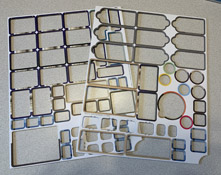

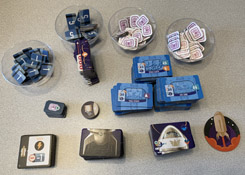
Next, I go through the component description page of the rules and begin organizing them. During this introduction to the components, I am learning what things are called and what their shapes and sizes are. I'm also seeing how components are grouped, too. Another thing I do is to group player parts into colored sets. Now it's time to get them into a storage solution.
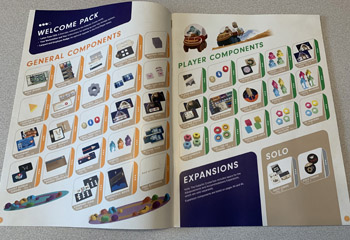


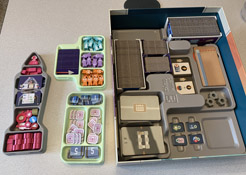
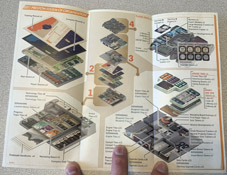
More and more games are coming with customized trays to store components in. Some are really great, as in the case of Galactic Cruise. It even included a very detailed pamphlet on where things went in the trays and how the fit in the box (see left). Some trays are terrible and I simply throw them away in favor of labeled plastic bags. If you're interested in my thoughts on this, you can read about it here.
But, regardless of how I store the stuff in the box, this process gives me a really good chance to learn the names of the various components as well as see their sizes and art work. This will help me later when reading the rules. Strangely, I think this is one of the most important steps because when I read in the rules, "Trade in your Cruise Token," and I don't know what a Cruise Token is, the entire rule is less likely to get committed to memory because it doesn't have another one to which to connect. Again, I'm trying to make connections and organizing the components can be considered the raw facts stage.
Time: 30-45 minutes
The next thing I do is use the rulebook and set a 2-Player game. Most modern games have a enumerated list and an image of the game which makes setting up much easier. Older games, such as El Grande (1995), simply have a list of written steps with no images and they are so much harder to confirm you're doing it right. Nevertheless, setting up a game allows me to get to know the components better including where they live in relation to each other on the board and player boards (remember, my memory is spatially focused).
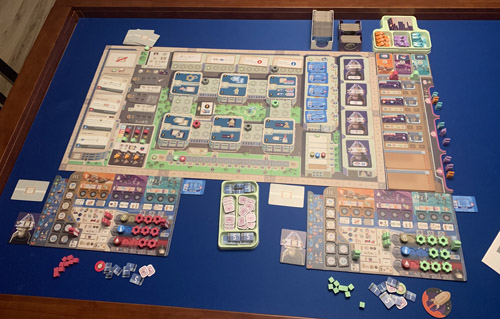
This step is usually straight forward and isn't too mentally taxing. The best part is I get to feel the excitement of playing my new game!
Time: 20 minutes
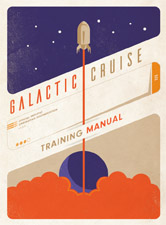
This is when it starts to get real. I either sit down in front of the set up or nearby in a comfortable chair and I begin reading the rulebook. But I don't read it straight through nor word-for-word. For games at this weight, that's too much content for me to compile and memorize simply by reading. Instead, I read about 40%-50% if the rulebook's content.
This means I read the game-flow pages, the summary of a player's turn, and other "overview" sections. In term of the rules detailing the game's actions, I skip over them only reading their headers and looking at their main icons and where they can be found on the board. I don't read how each action works nor any of the nitty-gritty details. Finally, I scan over the end-game triggers and scoring, but I don't read them in depth because often those things won't make much sense yet.
I probably only spend a max of 20-30 minutes doing this. If I find my self zoning out, that usually means it's more detail than I need and just skip a head. If there's a Player Aid, I'll look over it, too, because they usually only have higher-level information which is exactly what I'm looking for. Also, if there's a reference book, I'll scan through it, but often the verbose icons are more than detail than I'm looking to absorb at this time.
Time: 20-30 minutes
The next step is to find and watching a quality instructional video. I find the game on BGG and go to its Videos page. There I filter by Instructional and sort by Top. This gives me the most highly rated rules videos.
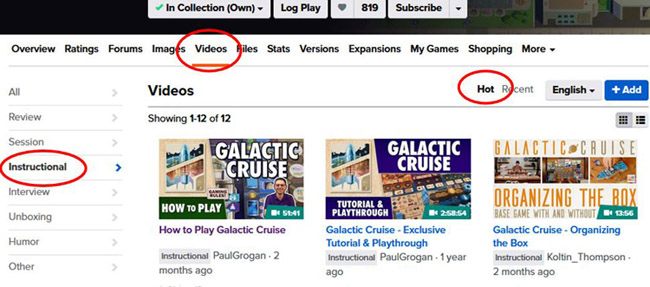
For heavy games, I really like the videos produced by Paul Grogan (BGG profile) at Gaming Rules! His videos are complete, well sequenced, and often answer the question I have in my mind with an example right as the question pops into it. While they are dense and somewhat dry, I prefer that for a verbose rules teach. I don't need jokes or opinions when learning the rules of a heavy game; they are distracting.
I also like Rodney Smith (BGG profile) at Watch it Played!, but he tends to lean more to mid-weight games. Like Grogan, Smith's videos are also complete and well sequenced. Plus, his friendly demeanor and energetic mannerisms remind me a lot of a long-time gamer friend of mine.
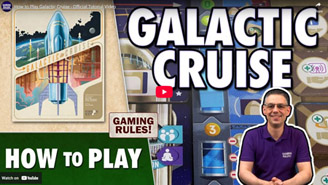
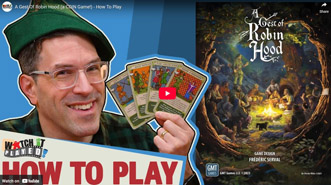

And while Tom Vasel (BGG profile) at The Dice Tower is more of a game review creator, I like his videos a lot, too. Because his videos are less about rules teaching and more about giving an overview and review, I only watch his if an instructional-specific video doesn't exist.
I typically avoid instructional videos with two creators sitting side-by-side. More often than not, they don't have well scripted segues between each other's comments and therefore often interrupt one another with, "And here is some fact the other person missed..." It's like one of them knows the game well and is teaching while the other one is just tying to get a word in to justify why they are there. Personally, I find it distracting and hard to learn from.
Regardless who made the video I'm watching, however, I don't bother to reference the rulebook much while watching. I just sit and relax. That said, I keep it nearby in case I want to clarify something that didn't make sense during video. Again, the idea is not to overload my brain with multiple things at once, and focusing on the video is usually enough for this step.
Time: 45-60 minutes

Now that I've watched a video and gotten a pretty good review of the rules, I fully read the rulebook. This is when I read every word including the full round details, all action sequences, and every example. This means lots of focus because I want to be able to think to myself "That makes sense" after every section. If I can't or I realize I've zoned out, I re-read the section.
Sometimes, I sit in front of my 2-Player game and move bits around so I can learn where they are in relation to other bits. Sometimes, if something in the book isn't making sense, I'll re-watch that section of the instructional video to get clarification.
This is probably the hardest part of my entire process. It requires concentration and focus, but hopefully enough knowledge is already in my brain from the previous steps that this becomes an exercise of adding to existing connections instead of raw learning.
Time: 45 minutes
Now that I, assumingly, know the game, I sit down and play 3 or 4 rounds of the game by myself. Since the game is already set up for two players, I play both players and take actions back in forth. This allows me to get accustomed to the mechanics of taking turns. With little strategy in mind, I try to take turns that exercise every main action. I'll perform the actions in full, often referring to the rulebook to make sure I get everything right. This allows me to really learn the actions and their nuances, which, in my opinion, is the hardest part of internalizing long rulebooks because they have the most details.
If I feel like it, I'll play a bit more and try to sequence combos and other strategies. Having played many, many different games over the years, I usually can garner a basic understanding of strategies based on the rules and mechanics. So, if I'm inclined, I'll try out those ideas a bit, too.
This step is optional and sometimes I skip it. I only do it if I'm alone and really want to play the game some. If I have a ready player with me and we have the time for a full game at learning speed, I'll just skip to the next step where I teach the game.
Time: 30 minutes

Now it's time to put my knowledge to the test. I reset the game and try to teach everything I know to someone else. At this point, I should be able to do with minimal references to the rulebook. However, experienced players always have edge-case questions that I often have to look up. But that's OK, by asking those questions, that means they are understanding the game well enough to think about those cases.
In terms of learning, teaching someone else is the best way for you to solidify what you know. As such, teaching a game is a big step to becoming an expert at it. Not only are you organizing your own knowledge, but they often ask questions that you haven't thought of yet. In terms of game rules, that process will help you learn where to find the answers quickly across the multiple books and sheets and stuff that come with heavy games now a-days.
If the teach goes clunky, that's OK, too. Don't give yourself a hard time. After all, you just learned the game yourself without the benefit of having someone teaching you!
Time: 45-60 minutes
Finally! It's time to play the game. The players I just taught and I play our first game as best we can. This often slow going the first couple of rounds as we all are trying to figure out what to do (strategically) and then how to do it (mechanically). Of course, I keep the rulebook (et al) nearby for quick look-ups. If there are a questions or clarifications I can't find answers for, I'll jot them down to look up on BGG later (see below).
The first few times we do a particular action or a scoring phase, I will get the book and read the relevant section word-for-word to make sure we didn't miss something minor. This is surprisingly important because it's very easy to miss something minor or do something out of order which then becomes your understanding of the game. If you're going to be a teacher for heavy games, it's critical that you know even the most minor of details.
By mid-game, we are usually rolling right along. There is always the inevitable, "I wish I had done that differently earlier." But it's a learning game, so we try not to dwell on those things. In the end, if it's a really good, fun game, we will all agree that we can't wait to play again with what we know!
Time: 120-150 minutes
After the first full game, I think about all of edge-case rules I had to look up, especially ones I couldn't find a definitive answer in the book(s). I then scroll through the Rules Forum for the game on BGG. I usually sort by "Top" (i.e. most thumbs up) and begin reading those first. That is because those seem to be the questions people have needed the answer for the most. Often, heavy games will have a consolidated FAQ or Clarifications thread, too, which I'll read through.
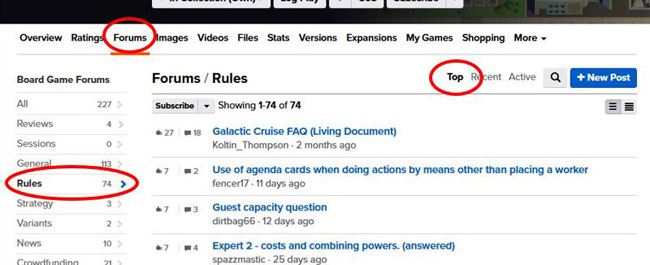
If I did a good job learning the game, most of the time I'm like, "yep, knew that," or "got that right." But sometimes one makes me think, "AH! Yes, that makes sense!" or "yep, got that wrong." This process really helps solidify the nuanced rules for edge cases. It also helps me understand the game in general, too.
For the questions I jotted down while playing, this is when I'll post them if I couldn't find the answers in any of the threads.
Time: 15-20 minutes
So, there you have it. It's my full process for receiving a heavy game like Galactic Cruise or Lisboa or Inventions and learning them from scratch to the point where I can teach someone the rules just before my first play. The weakness of this method is it doesn't teach me much in the way of logical strategy. I have to figure that out as I go. But my experience with other heavy games gives me some notion of what to do.
My process, not including the time it takes to play the game for the first time, can take upwards of 4 to 5 hours! That seems like a lot of time until you realize at the end of it, I have learned and taught a heavy, hard game that was nearly sight-unseen.
Good luck and let me know if you have any methods that have worked for you.